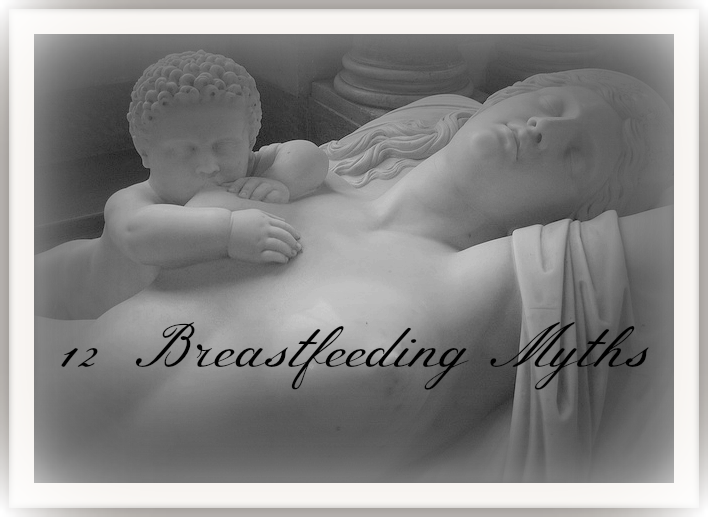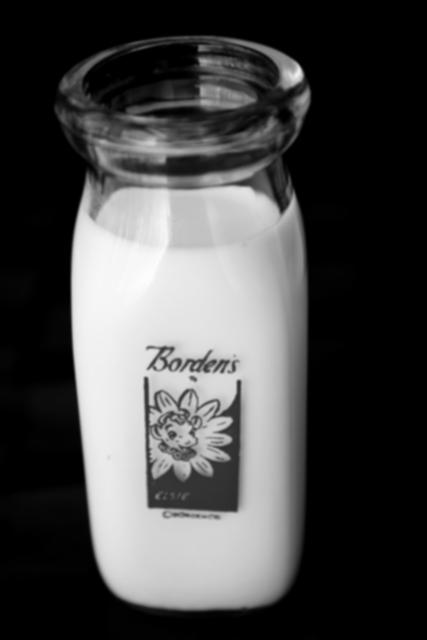Dispelling myths about breastfeeding has been a huge passion of mine ever since I began to realize that low breastfeeding rates can be attributed to the massive amount of misinformation out there. I have talked to so many women who thought they had to stop nursing for one reason or another, even though the nursing relationship was still mutually beneficial for them and their babies.
Obviously each family must make decisions that are right for their individual circumstances. Making these decisions in a fully informed manner can help mothers know they made the best decisions possible for the circumstances they were in at the time—with full knowledge.

Breastfeeding Myth #1
Mothers with small breasts will not make enough milk.
Breast size has no bearing upon ability to produce sufficient amounts of milk. Some small-breasted women even have issues with overabundant supply! Nursing on cue (whenever baby indicates a desire to nurse) is what ensures an adequate milk supply, not breast size.
Breastfeeding Myth #2
The hospital staff is in charge of baby’s feedings until you are discharged.
There is a very common misconception that hospital nurses can dictate what the baby eats before hospital discharge. This boils down to an issue of patient rights and parental custody. Hospital staff cannot do anything (including administration of bottles, pacifiers, sugar water, etc.) without parental consent. Although the calling of protective services is sometimes threatened when parents won’t be cajoled into catering to the wishes of the staff, these threats rarely come to fruition.
With the advent of UNICEF/WHO’s Baby Friendly Hospital initiative, more awareness is being raised about these issues, and hospital staff persons are becoming more well-informed. Rooming in with your baby is an excellent way to keep an eye on what goes into your baby, as is having a partner or grandparent accompany the baby for any procedures that take place outside of the room.
Breastfeeding Myth #3
Breasts need time to “fill up” between feedings.
Milk is constantly being produced in the breasts, so they are never completely empty. When a baby takes in a relatively large feeding, they generally consume about 75-80% of the milk available in the breast. Because milk production is a supply-and-demand process, removing milk from the breast stimulates the production of more milk. It is impossible to ever completely empty the breast! Therefore, there is no need to wait any particular length of time between nursing sessions to allow the milk to replenish itself.

Breastfeeding Myth #4
You must drink milk to make milk.
Cows don’t need to drink milk to make milk, and neither do humans! Adequate amounts of calcium can be obtained from other sources such as bony fish, seeds, and nuts. Ounce for ounce, leafy greens such as spinach and kale have more calcium than dairy products.
Breastfeeding Myth #5
I don’t get much milk when I pump, so my baby must not be getting much.
Baby is much more efficient at extracting milk from the breast than a pump. The amount that a mother is able to pump is not indicative of how much milk the baby is getting. Mothers who nurse their babies at the breast full-time are usually able to pump between 0.5 oz and 2 oz per 10-20 minute pumping session.
Breastfeeding Myth #6
Night feedings are not important.
Levels of prolactin (the milk-producing hormone) are highest during the late night and early morning hours, so night feedings, particularly in the first few months, are crucial to maintaining an adequate milk supply. These feedings can be made easier by sleeping with the baby nearby for more convenient and easier feedings, and less wakefulness for everyone involved.
Breastfeeding Myth #7
You cannot drink alcohol while breastfeeding.
Although studies have shown that babies tend to consume less milk after a mother has ingested alcohol, it is not necessary to “pump and dump,” and this will not remove alcohol from the breastmilk any faster. Less than 2% of the alcohol consumed by the mother reaches the milk, and alcohol content in the milk peaks between 30 and 60 minutes after taking a drink.
The age of the nursing child must also be taken into account, since the liver of the newborn will have a more difficult time metabolizing alcohol than the liver of an older infant or toddler.
Breastfeeding Myth #8
You must pump and dump after medical procedures, taking medications, etc.
If you’ve read a label on almost any medication, you will have noticed a warning that says “Use with caution if pregnant or breastfeeding.” Even some prenatal vitamins have this warning! Many drugs have not been studied by the FDA for use in breastfeeding mothers. This warning is placed as a way to reduce liability.
In reality, there is almost always a safe option for breastfeeding available. Dr. Thomas Hale, a clinical pharmacologist at the Texas Tech University School of Medicine, is one of the leading researchers in the field of lactation and medications. Every few years, he publishes a new edition of his book, Medications and Mother’s Milk, which is an excellent resource for finding out whether drugs are compatible with breastfeeding. The book itself is a bit on the pricey side, but most La Leche League leaders or lactation consultants have access to a copy.
Breastfeeding Myth #9
You must stop breastfeeding when mom or baby are sick.
Neither mother nor baby being sick necessitates the cessation of breastfeeding. When a mother is ill, the baby has been exposed to her illness before she even began showing symptoms, and the mother’s body is already producing antibodies which can be passed through the breastmilk to help protect the infant.
Breastfeeding is also one of the best things you can do for a sick infant. Besides the antibodies provided to the baby, breastmilk also contains a better balance of nutrients and electrolytes than a replacement drink like Pedialyte.
If a baby seems to be throwing up everything he is eating, a mother can nurse the baby about 30 seconds past the initial let-down sensation and then stop. This provides the baby with more foremilk, which is lower in fat content and is more easily tolerated by an upset tummy. This process can be repeated every 15-20 minutes (generally alternating breasts) until the baby has managed to keep something down.
Breastfeeding Myth #10
Supplementation with water is necessary in hot weather.
Babies get all the liquids they need from breastfeeding. Especially for newborns, giving water supplements can be dangerous and can lead to a life-threatening condition known as oral water intoxication. The water content in breastmilk also rises in warmer weather, so babies get plenty of hydration from breastfeeding on demand.
Breastfeeding Myth #11
Breastfeeding past ___ age has no benefit for baby.
The age at which people say that nursing ceases to be valuable seems to vary greatly each time I hear this myth! In fact, some antibodies in breastmilk increase in concentration as a child moves closer to weaning, regardless of age. World wide, the average age of weaning from the breast is around age 4, and a child will not continue to breastfeed when he has no need to do so. All the benefits of breastfeeding, both physical and emotional, continue for as long as the nursing relationship is mutually beneficial for both mother and child.
Breastfeeding Myth #12
Weaning will solve whatever issue you are having.
This myth is especially common when discussing sleep issues or a high-needs infant or toddler. It is important to keep in mind that nursing doesn’t make a child need you less, it just gives you one less tool to meet their needs.
Are there any of these myths that you thought we’re true – do any of them surprise you?
Be sure to check out all of the posts in the Breastfeeding & Beyond series!
. . . .
We encourage you to submit any question you have about breastfeeding or topics you would like us to cover in this series. Leave a comment on any post in the series or submit your question/topic privately using this form.
Rachel Wideman lives with her husband Andrew and their 3-year-old son Caleb. She is a registered nurse, La Leche League leader, and enjoys reading and scrapbooking.
Original article and pictures take www.intoxicatedonlife.com site
Комментариев нет:
Отправить комментарий